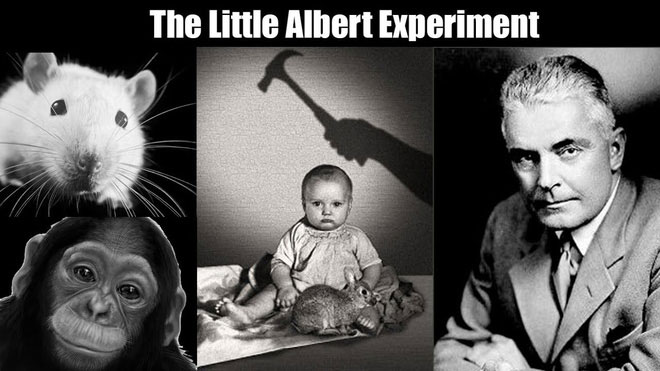'Little Albert' - One of the most terrible experiments in history
Historically, people have done many famous experiments, among which can not help but mention the extremely horrifying experiment called "Little Albert".
In 1920, John Watson, a psychologist obsessed with Ivan Pavlov's study of conditional reflexes , was also the father of behavioral theory, and always advocated the use of orphans. into his studies.

Nine-month-old baby boy Albert participated in the experiment.
He wanted to test whether fear was congenital or conditioned so he chose a 9-month-old child named Albert, the son of a hospital nurse.
After contacting Albert's mother, Watson talked to her about the experiment and that her child would have a reward every day, but specifically how the experiment took place he absolutely did not explain.
Nine-month-old Albert, also known as "little Albert" , participated in the experiment. At first, Watson often gave small animals like puppies, rabbits or white mice as gifts for the boy. Albert initially liked them and showed no signs of fear. After a basic emotional test, Watson concluded that Albert was not afraid of small animals.
Two months later, Watson officially embarked on his "gruesome" experiment. Watson handed a white mouse to Albert. Whenever the boy touches the mouse, Watson will make a loud sound behind him by knocking a hammer against a steel rod hanging high above him, which both frightens him and the mouse.
At this time, Albert began to cry and was afraid of the loud sound. This situation was repeated many times later, while Albert began to show fear of the mouse and crawl, crying in fear whenever the mouse appears.
Later, Watson discovered that Albert was not only afraid of guinea pigs, but that his fear also began to generalize, even for puppies, white, fluffy fur coats, etc. Everything with fur made him scared.

The "Little Albert" experiment subsequently sparked widespread criticism mainly about the experiment's ethics.
Through this experiment, Watson proved that fear emotions can be learned through conditioned reflexes . But before Watson could continue the experiment, someone took Albert away.
What makes many people resent is the fact that scientists have caused children to suffer psychological and physical injuries when their ears are still too fragile.
The "Little Albert" experiment subsequently sparked widespread criticism in the academic world, mainly on the ethics of the experiment.
Since this experiment, the American Psychological Association has developed an empirical rule that prohibits people from conducting unethical experiments to ensure ethical issues for scientific experiments .
- The most horrifying experiments in the history of world science
- The most "inhumane" psychological experiment in history and the controversial facts behind it
- The most gruesome human experiments in history
- What scientists did with Albert Einstein's brain
- Albert Einstein's most expensive watch in history
- The 10 most beautiful experiments in history
- Science experiments that change the world (II)
- 5 physics revolutionary fantasy experiments by Einstein
- 10 terrible disasters in human history
- 10 most brutal experiments on the human body
- The son carries the 'bad gene' of genius Albert Einstein
- The most macabre experiments in the history of world science
- View from the perspective of climate change
- Try 'brainstorming' with interesting psychological experiments
 'Fine laughs' - Scary and painful torture in ancient times
'Fine laughs' - Scary and painful torture in ancient times The sequence of numbers 142857 of the Egyptian pyramids is known as the strangest number in the world - Why?
The sequence of numbers 142857 of the Egyptian pyramids is known as the strangest number in the world - Why? History of the iron
History of the iron What is alum?
What is alum? The Tragedy of Albert Einstein's Children: One Disappeared Mysteriously, One Went Crazy and Died Alone
The Tragedy of Albert Einstein's Children: One Disappeared Mysteriously, One Went Crazy and Died Alone  See the beautiful Greenland, but it can soon be lost forever
See the beautiful Greenland, but it can soon be lost forever  The son carries the 'bad gene' of genius Albert Einstein
The son carries the 'bad gene' of genius Albert Einstein  The fatal mistake of genius
The fatal mistake of genius  Blood stains on the mysterious 83-year-old leaf on the death of the Belgian king
Blood stains on the mysterious 83-year-old leaf on the death of the Belgian king  The ship Albert Einstein left the launch pad to bring supplies to ISS
The ship Albert Einstein left the launch pad to bring supplies to ISS 